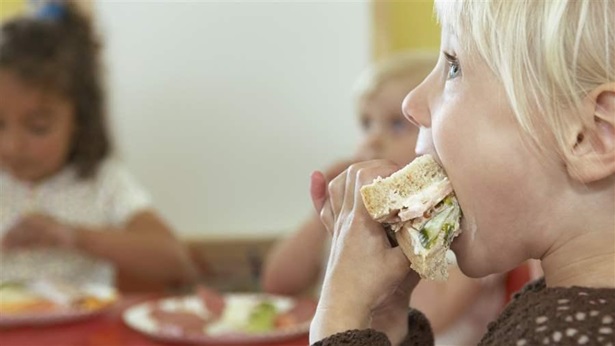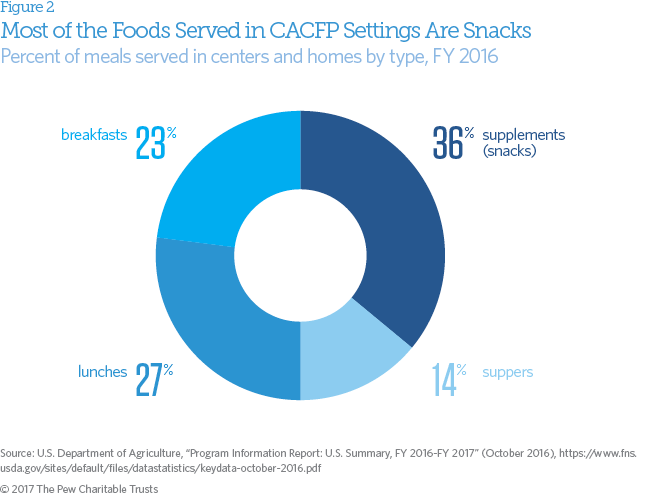Healthier Nutrition Standards Benefit Kids
A health impact assessment of the Child and Adult Care Food Program’s updated rules for meals and snacks
Each day across the United States, more than 4 million children, many from low-income families, receive meals and snacks through the U.S. Department of Agriculture’s (USDA) Child and Adult Care Food Program (CACFP).1 The program, which began as the Child Care Food Program in 1968, provides funding for these foods, in the form of reimbursements, to a variety of child care, after-school, and adult day care institutions that serve young children, older adults, and chronically disabled people. Through CACFP, the USDA aims to ensure that all of these vulnerable populations have daily access to nutritious foods.
As part of the Healthy, Hunger-Free Kids Act of 2010, Congress directed the USDA to review and update CACFP nutrition standards to align more closely with the 2010 Dietary Guidelines for Americans (DGAs).2 In early 2015, based on science-based recommendations from the National Academies of Sciences, Engineering, and Medicine’s Health and Medicine Division (formerly the Institute of Medicine), the USDA proposed several adjustments to CACFP standards to better meet children’s nutritional needs without increasing costs.
Shortly after these updates were proposed, the Kids’ Safe and Healthful Foods Project—a collaboration between The Pew Charitable Trusts and the Robert Wood Johnson Foundation—launched a health impact assessment (HIA) to analyze how the proposed CACFP rule—the first significant update to the program’s standards in nearly 50 years—might affect the overall health of children up to age 5 who are served by CACFP in centers and family child care homes.
The new rule should improve the nutritional quality of CACFP-funded meals and snacks, increasing children’s intake of whole grains and vegetables, decreasing their consumption of grain-based desserts, and having a positive overall impact on their health.
HIAs bring together research, health expertise, and stakeholder input to identify the potential and often-overlooked effects on public health of proposed laws, regulations, projects, policies, and programs. For this assessment, the HIA team examined peer-reviewed literature as well as reports and publications outside of academic journals on CACFP meals and snacks, the health disparities among CACFP-enrolled children, nutrition-related health outcomes, and policy interventions that could improve children’s overall consumption of healthy foods. In addition, the HIA team constructed and analyzed hypothetical menus and examined potential costs based on the various foods providers may choose to meet the new standards. The team also gathered input from stakeholders, including providers, parents, state agency personnel, sponsors—organizations that oversee family child care homes and centers and report to the state on their behalf—and others in the CACFP community. The HIA did not address external factors, such as children’s exercise behaviors and eating patterns outside of CACFP, which are largely driven by parents’ food choices as well as economic and neighborhood contexts.
In April 2016, as the HIA was underway, the USDA finalized its updated CACFP standards to require that meals and snacks include a greater variety of fruit and vegetables, more whole grains, and less added sugar and saturated fat. The department also outlined a number of best practices to help early care and education (ECE) providers build on the standards and to highlight areas where centers and homes may take additional steps to improve the nutritional quality of the foods they serve. The final rule reflects most of the changes that were in the proposal and that were addressed by the HIA. Providers must comply with the rule’s provisions by Oct. 1, 2017.
The HIA team considered seven research questions:
- How would the USDA’s proposed changes affect the nutritional quality of food served in ECE settings that adhere to CACFP standards (CACFP and non-CACFP participants)?
- How would the changes affect dietary consumption for children in ECE settings that follow CACFP nutrition standards (CACFP and non-CACFP participants)?
- How would changes in children’s dietary consumption affect health outcomes for children in settings that follow CACFP nutrition standards (CACFP and non-CACFP enrollees, particularly the most vulnerable groups of children, such as racial or ethnic minorities and those living in food deserts, that is, areas with little or no access to quality foods)?
- How would changes in dietary consumption affect the attitudes toward healthy foods of children, families, and ECE provider administrators and staff?
- How would changes to the standards affect providers’ costs and fiscal stability?
- How would changes to the standards affect food-related costs for CACFP settings and in turn affect participation in the meal program?
- How would the changes to the nutrition standards affect food distribution costs and other food system mechanisms?3
Based on the proposed rule, the HIA team concluded that some of the final rule’s provisions—such as requirements for whole grains, fruits, and vegetables—will maximize positive health effects on the children served by CACFP, while others, including those related to milk, will be neutral. What is less clear is how the changes in provider costs and participation will affect children’s health. For children from low-income families in particular, enrollment in CACFP can mitigate various risk factors, such as being overweight or obese, anemic, and food insecure, so if providers leave the program because of higher costs or other changes associated with the proposed rule, fewer children will reap those benefits.
The key findings from the HIA process are:
- The new rule should improve the nutritional quality of CACFP-funded meals and snacks, increasing children’s intake of whole grains and vegetables, decreasing their consumption of grain-based desserts, and having a positive overall impact on their health. The final rule standards separate fruits and vegetables into individual meal components and allow providers the flexibility to serve two vegetables at lunch and supper. Additionally, at least one grain serving a day must be whole grain-rich and providers cannot be reimbursed for serving grain-based desserts. These shifts toward increased whole grains and vegetables may result in greater consumption of commonly underconsumed nutrients, such as vitamins D and E, and reduced consumption of commonly overconsumed nutrients, such as saturated fats and added sugars. The resulting improved nutritional quality could lower CACFP-enrolled children’s risk of being overweight or obese, and the increased consumption of healthier foods could influence children’s overall diet, including in settings outside of ECE, which could maximize health benefits.
- Nutrition education, training, and technical assistance, along with increased service of nutrient-dense meals and snacks at ECE settings, may positively affect providers’, parents’, and children’s attitudes toward healthy foods. However, improved attitudes toward nutritious foods—particularly among parents whose behaviors may be influenced by social and economic factors—are not always predictive of improvements in diet quality or consumption.
- Changes to the nutrition standards may result in small to moderate provider cost increases depending on the foods selected, which could lead to a decrease in provider participation in the program. However, the extent of cost increases will vary based on provider choices and available resources, which are often dictated by the size, type, and location of each setting, as well as on the price and quality of foods they currently serve.
- All children under the care of a provider following CACFP standards, even those whose meals may not be eligible for reimbursement, would probably benefit from the nutritional updates. The impact that changes to CACFP meal standards have on non-CACFP providers serving food to children will be dictated in part by whether and how each state’s ECE licensing regulations link to the CACFP guidelines.
The HIA recommends that providers incorporate best practices into their menus and that Congress, the USDA, state agencies, providers, and sponsors adopt policies and practices to improve the nutrition and overall health of CACFP-enrolled children.
- Consider additional strategies—such as increasing vegetable serving sizes and limiting added sugars, salt, and fat in fruit and vegetable dishes—to improve consumption of nutrient-dense foods. Although these approaches were not included as part of the proposed rule, they were supported by the HIA’s research and input from stakeholders.
- Encourage providers to adopt a phased-in implementation timeline, extend for up to three years the current one-year transition period during which providers are not penalized for minor errors, and provide training and technical assistance to support adoption and sustainability of the rule and to help providers comply with program requirements.
- Conduct a review of CACFP’s reimbursement rates and eligibility requirements to identify areas that may hinder the program’s effectiveness and ability to maximize health impacts.
As the CACFP community moves closer to implementation of the final nutrition standards and as the program expands, ongoing study of the broader ECE field would provide useful information about the reach of CACFP standards to non-CACFP settings and would help to compare the types of foods the latter group of providers are serving with what the law requires.
This report examines the HIA findings in depth and looks at how they relate to the final rule, with added suggestions to support providers during implementation.
Endnotes
- U.S. Department of Agriculture, “Child and Adult Care Food Program: Data as of Jan. 6, 2017,” accessed Jan. 31, 2017, https://www.fns.usda.gov/sites/default/files/pd/ccsummar.pdf; U.S. Department of Agriculture, “Child and Adult Care Food Program: Why CACFP is Important,” accessed June 13, 2016, http://www.fns.usda.gov/cacfp/why-cacfp-important.
- U.S. Department of Agriculture, “Hunger-Free Kids Act,” news release, Dec. 16, 2010, https://www.fns.usda.gov/tags/hunger-free-kids-act.
- The HIA team was unable to answer this research question because of the limited ability of CACFP to effect changes within the larger food distribution and delivery environment and inadequate resources to pursue additional investigation in this area.
Latest from Health


4 Million Kids in Early Care and Education Settings Will Soon Get Healthier Foods
New standards will improve nutrition; providers can maximize benefits by adopting best practices








